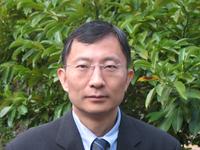The Texas A&M University Institute for Advanced Study (TIAS) announced its 2016-17 class of Faculty Fellows, which includes four who will be part of the Texas A&M University College of Engineering.
The class, which includes 10 distinguished scientists and scholars who are nationally or internationally renowned for conducting groundbreaking research in chemistry, mathematics, engineering, medicine, astronomy, atmospheric science, marketing or law, will be inducted during the institute’s annual gala in early 2017.
Joining the college of engineering are Dr. Christopher C. Cummins; Dr. Ingrid Daubechies; Dr. Huajian Gao; and Dr. Maryellen Giger.
The newest class of Faculty Fellows includes members of the United States’ National Academies as well as representatives from major scientific or professional organizations in the United States, the United Kingdom, Canada and Germany.
Each Faculty Fellow will partner with one or more of the departments offering graduate degrees housed in Texas A&M’s 16 colleges or schools at Texas A&M’s branch campus in Galveston. The institute provides fellowships for graduate students to work with Faculty Fellows, as well as funding to support visiting graduate students and post-doctoral researchers affiliated with the Faculty Fellows.
A long-time champion of the Institute, Chancellor John Sharp of The Texas A&M University System provided the funds that launched TIAS in 2010.
“The talent that the TIAS program brings to Texas A&M is causing everyone else in higher education to take notice,” Chancellor Sharp said. “It was money well spent to enrich the academic experience with such world-class scholars and researchers.”
President Michael K. Young of Texas A&M University said, “This fifth class of TIAS Faculty Fellows offers truly outstanding credentials. In collaboration with our exemplary faculty, these Fellows will sustain the extraordinary trajectory of TIAS, inspire truly transformative intellectual experiences among our students, and advance the international reputation of the Texas A&M research enterprise.”
Provost and Executive Vice President Karan Watson said, “Each of these remarkable individuals offers a strong portfolio of world-class accomplishments in their fields. As we have seen with the previous four classes of Faculty Fellows, the research that will emerge from their collaborations with our own outstanding faculty and students will be exciting and extraordinary.”
Each year, the institute selects its Faculty Fellows from among top scholars who have distinguished themselves through outstanding professional accomplishments or significant recognition.
Former classes have included two Nobel laureates, a Wolf Prize recipient, a recipient of the Hubble Medal in Literature for Lifetime Achievement, a recipient of the National Medal of Science, an awardee of the National Medal of Technology and Innovation, a recipient of the highest award in architecture and a two-time recipient of the State Prize of Russia.
TIAS Founding Director John L. Junkins said, “This fifth class of 10 outstanding scholars have intellectual strengths centered in six colleges, however their scholarship impacts many disciplines. These Fellows being in residence afford our faculty and students extraordinary opportunities to collaborate one-on-one with top people in their fields. We expect game-changing and life-changing outcomes as a consequence.”
 Christopher C. Cummins, Henry Dreyfus Professor of Chemistry, Massachusetts Institute of Technology – Among the most innovative synthetic chemists of his generation, known for his impact on small molecule activation, Cummins is a member of the American Academy of Arts and Sciences and a corresponding member of Germany’s Göttingen Academy of Sciences and Humanities. Cummins will collaborate with faculty-researchers from the college of science and the college of engineering.
Christopher C. Cummins, Henry Dreyfus Professor of Chemistry, Massachusetts Institute of Technology – Among the most innovative synthetic chemists of his generation, known for his impact on small molecule activation, Cummins is a member of the American Academy of Arts and Sciences and a corresponding member of Germany’s Göttingen Academy of Sciences and Humanities. Cummins will collaborate with faculty-researchers from the college of science and the college of engineering.
 Ingrid Daubechies, James B. Duke Professor of Mathematics and Electrical and Computer Engineering, Duke University – One of the world’s most cited mathematicians recognized for her study of the mathematical methods that enhance image-compression technology, Daubechies is a member of the National Academy of Engineering, the National Academy of Sciences and the American Academy of Arts and Sciences. Daubechies will collaborate with faculty-researchers from the college of science and the college of engineering.
Ingrid Daubechies, James B. Duke Professor of Mathematics and Electrical and Computer Engineering, Duke University – One of the world’s most cited mathematicians recognized for her study of the mathematical methods that enhance image-compression technology, Daubechies is a member of the National Academy of Engineering, the National Academy of Sciences and the American Academy of Arts and Sciences. Daubechies will collaborate with faculty-researchers from the college of science and the college of engineering.
 Huajian Gao, Walter H. Annenberg Professor of Engineering, Brown University – Known for his research into micromechanics, the basic principles that control mechanical properties and behaviors of materials in both engineering and biology, Gao is a member of the National Academy of Engineering. He will collaborate with faculty-researchers in the college of engineering.
Huajian Gao, Walter H. Annenberg Professor of Engineering, Brown University – Known for his research into micromechanics, the basic principles that control mechanical properties and behaviors of materials in both engineering and biology, Gao is a member of the National Academy of Engineering. He will collaborate with faculty-researchers in the college of engineering.
 Maryellen Giger, A.N. Pritzker Professor of Radiology and College Vice-Chair for Basic Science Research, The University of Chicago – An expert in computer-aided diagnosis as well as digital signal and image processing, Giger is a member of the National Academy of Engineering. She will collaborate with faculty-researchers in the college of engineering as well as with scientists and clinicians in the Texas A&M Health Science Center, the Houston Medical Center and local hospitals.
Maryellen Giger, A.N. Pritzker Professor of Radiology and College Vice-Chair for Basic Science Research, The University of Chicago – An expert in computer-aided diagnosis as well as digital signal and image processing, Giger is a member of the National Academy of Engineering. She will collaborate with faculty-researchers in the college of engineering as well as with scientists and clinicians in the Texas A&M Health Science Center, the Houston Medical Center and local hospitals.
About the Texas A&M University Institute for Advanced Study: The Texas A&M University Institute for Advanced Study was established in December 2010 by The Texas A&M University System Board of Regents to build on the growing academic reputation of Texas A&M and to provide a framework to attract top scholars from throughout the nation and abroad for appointments of up to a year. The selection of Faculty Fellows initiates with faculty nominations of National Academies and Nobel Prize-caliber scholars who align with existing strengths and ambitions of the University. To learn more, visit http://tias.tamu.edu.
About Research at Texas A&M University: ?As one of the world's leading research institutions, Texas A&M is at the forefront in making significant contributions to scholarship and discovery, including that of science and technology. Research conducted at Texas A&M represented annual expenditures of more than $866.6 million in fiscal year 2015. Texas A&M ranked in the top 20 of the National Science Foundation’s Higher Education Research and Development survey (2014), based on expenditures of more than $854 million in fiscal year 2014. Texas A&M’s research creates new knowledge that provides basic, fundamental and applied contributions resulting, in many cases, in economic benefits to the state, nation and world. To learn more, visit http://research.tamu.edu.